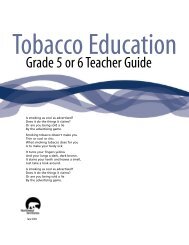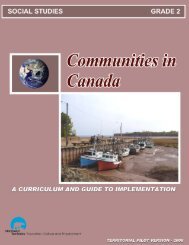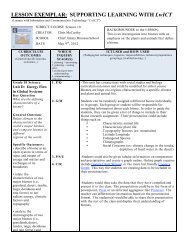Anaphylaxis: A Handbook for School Boards - Education, Culture ...
Anaphylaxis: A Handbook for School Boards - Education, Culture ...
Anaphylaxis: A Handbook for School Boards - Education, Culture ...
You also want an ePaper? Increase the reach of your titles
YUMPU automatically turns print PDFs into web optimized ePapers that Google loves.
Elements of Board Policies<strong>School</strong> board policies and guidelines on anaphylaxis vary according to the needs and organizationalrequirements of individual boards and communities. In all cases, their objective is to provide a safeenvironment <strong>for</strong> anaphylactic students, to promote an understanding of their needs to the wider schoolcommunity, and to provide guidelines that allow school staff to respond to individual circumstances andprovide emergency treatment to the anaphylactic child.The following policy components suggest elements that boards may wish to include, based on anexamination of existing policies and the recommendations of professionals involved with anaphylaxis. Sincethey are based on an extensive review of school board policies on anaphylaxis from across the country, thoseusing this handbook as an aid to policy development should understand that not all recommendations will besuitable and/or necessary in every situation. In the final analysis, boards will have to weigh these suggestedpoints against the recommendations coming from their own policy development process and thecircumstances in their own school communities.All policies and procedures should be flexible enough to respond to the age and maturity of the student,the nature and prevalence of the allergen, and the organizational and physical properties of the school itself.Some procedures will be appropriate <strong>for</strong> any life-threatening allergy. Others may be more applicable to peanutallergy in particular because of the widespread use and popularity of peanut products and the viscosity ofpeanut butter.In general, boards have found that a strategy of encouraging affected families to be involved with otherprofessionals in developing classroom educational programs has led to an open and balanced discussion ofrights and responsibilities. When the school community recognizes the right of parents to feed their childrenwhatever they choose, but acknowledges the right to life and safety as greater, most families are receptive topolicies and procedures that protect the allergic child.<strong>School</strong> boards must recognize and communicate to parents that, in spite of their best ef<strong>for</strong>ts, cooperationcannot be guaranteed and accidents may occur. However, once reasonable precautions have been taken,neither staff, parents, nor other students should feel responsible <strong>for</strong> accidental exposure. If accidentalexposure does occur, appropriate emergency measures must be in place and acted upon immediately.Most literature about anaphylaxis in school settings divides the school’s responsibility into three distinctcategories: in<strong>for</strong>mation and awareness, avoidance, and emergency response. This chapter organizespossible school board policy options into those three categories of activity.27
















